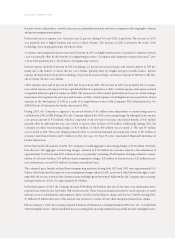American Express 2003 Annual Report Download - page 31
Download and view the complete annual report
Please find page 31 of the 2003 American Express annual report below. You can navigate through the pages in the report by either clicking on the pages listed below, or by using the keyword search tool below to find specific information within the annual report.
In 2003, the Company met or exceeded all of these targets. Diluted earnings per share (EPS) before accounting change of
$2.31 was up 15 percent from a year ago. The Company’s 2003 return on equity was 20.6 percent. Revenues totaled $25.9
billion, up 9 percent from $23.8 billion a year ago.
Over the past few years, the Company has made changes to increase its flexibility and improve its risk profile. These efforts
have included:
•Shifting away from the Company’s historic reliance on travel and entertainment spending to more stable everyday
spending activities;
•Diversifying revenue streams to incorporate revolving credit revenues in addition to historical spend-based revenues;
•Making aspects of the Company’s expense base more variable and creating a dynamic reengineering capability; and
•Continually enhancing credit, risk and investment management capabilities.
Management believes the Company has significant opportunities for organic growth and funded those opportunities in
2003. This funding contributed to increases in cardmember spending, cards-in-force and loan balances. In addition, the
Company also completed two acquisitions during the year, Threadneedle Asset Management Holdings LTD (Threadneedle),
an investment manager in the United Kingdom, and Rosenbluth International (Rosenbluth), a major corporate travel agency
with clients and operations around the world.
Looking forward to 2004, the Company expects continued growth in the United States and many other global economies
and continued strength and confidence in the financial markets. The Company believes its business momentum and com-
petitive capabilities in both the payments and retail financial services businesses will allow it to capitalize on these positive
trends and opportunities.
In September 2003, the Second U.S. Circuit Court of Appeals upheld a lower-court decision saying that Visa USA, Visa Inter-
national and MasterCard violated U.S. antitrust laws by prohibiting their members from issuing American Express and
Discover cards in the United States. Visa and MasterCard have announced their intent to seek Supreme Court review of this
decision. Subsequent to the Circuit Court of Appeals’ ruling, the Company announced an agreement with MBNA America
Bank, NA (MBNA) pursuant to which MBNA would become the first major bank in the U.S. to issue American Express-
branded credit cards. The Company does not expect a significant impact on EPS resulting from this agreement in 2004. The
MBNA agreement is a milestone for the Company, as well as for the entire U.S. credit card industry. Once banks are free to
issue cards on whichever network they choose, there will be increased competition, which will spur more innovation that
will deliver greater value to merchants and increased benefits for consumers. The Company will continue to talk with other
banks and financial institutions with a view towards ultimately forming a series of issuing partnerships in the United States.
CONSOLIDATED RESULTS OF OPERATIONS
Management believes the 2003 financial results illustrate the benefits of the fundamental changes made to its business and
the strong momentum resulting from the business-building expenditures over the last several years. The Company has
achieved strong growth in cardmember billings and lending balances, improved credit quality and higher client assets.
The Company’s 2003 consolidated income before accounting change rose 12 percent to $3.00 billion and diluted EPS before
accounting change rose 15 percent to $2.31. The Company’s 2003 consolidated net income of $2.99 billion rose 12 percent
from $2.67 billion in 2002 and diluted EPS of $2.30 increased 14 percent from $2.01 in 2002. The Threadneedle and Rosen-
bluth acquisitions together contributed less than 1 percent to the Company’s revenue and expense growth rate in 2003 and
had a negligible impact on net income and EPS for the year ended December 31, 2003. In 2002, both net income and EPS
were up significantly from 2001. The 2001 results included restructuring charges of $631 million ($411 million after-tax),
$98 million ($65 million after-tax) of one-time costs and waived customer fees resulting from the September 11th terrorist
attacks, and a charge of $1.01 billion ($669 million after-tax) reflecting losses in the high-yield portfolio at AEFA.
Net income and EPS for 2003 reflect the impact of the Company’s adoption of Financial Accounting Standard Board (FASB)
Interpretation No. 46, “Consolidation of Variable Interest Entities,” revised December 2003 (FIN 46), which addresses the
(p.29_axp_ financial review)
























